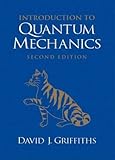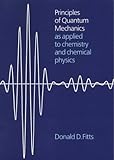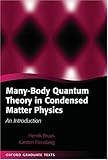|
|
Help |
| Home - Physics - Quantum Physics (Books) | |
e99 Online Shopping Mall
|
|
Help |
| Home - Physics - Quantum Physics (Books) | |
| Back | 41-60 of 100 | Next 20 |
click price to see details click image to enlarge click link to go to the store
| 41. Quantum Mechanics and Path Integrals: Emended Edition (Dover Books on Physics) by Richard P. Feynman, Albert R. Hibbs, Daniel F. Styer | |
 | Paperback: 384
Pages
(2010-07-21)
list price: US$19.95 -- used & new: US$12.69 (price subject to change: see help) Asin: 0486477223 Average Customer Review: Canada | United Kingdom | Germany | France | Japan |
|
Editorial Review Product Description Customer Reviews (5)
| |
| 42. Introduction to Quantum Mechanics (2nd Edition) by David J. Griffiths | |
 | Hardcover: 480
Pages
(2004-04-10)
list price: US$141.60 -- used & new: US$80.00 (price subject to change: see help) Asin: 0131118927 Average Customer Review: Canada | United Kingdom | Germany | France | Japan |
|
Editorial Review Product Description Customer Reviews (113)
| |
| 43. Quantum Mechanics with Basic Field Theory by Bipin R. Desai | |
 | Hardcover: 858
Pages
(2009-12-21)
list price: US$95.00 -- used & new: US$87.66 (price subject to change: see help) Asin: 0521877601 Average Customer Review: Canada | United Kingdom | Germany | France | Japan |
|
Editorial Review Product Description Customer Reviews (3)
| |
| 44. Principles of Quantum Mechanics: As Applied to Chemistry and Chemical Physics by Donald D. Fitts | |
 | Paperback: 364
Pages
(1999-08-28)
list price: US$70.00 -- used & new: US$10.00 (price subject to change: see help) Asin: 0521658411 Average Customer Review: Canada | United Kingdom | Germany | France | Japan |
|
Editorial Review Product Description Customer Reviews (2)
| |
| 45. Dr. Quantum Presents: Meet the Real Creator--You! by Fred Alan Wolf | |
 | Audio CD:
Pages
(2005-10-01)
list price: US$29.95 -- used & new: US$14.80 (price subject to change: see help) Asin: 1591793807 Average Customer Review: Canada | United Kingdom | Germany | France | Japan |
|
Editorial Review Product Description Customer Reviews (7)
| |
| 46. Principles of Quantum Mechanics by R. Shankar | |
 | Hardcover: 694
Pages
(1994-09-01)
list price: US$115.00 -- used & new: US$59.95 (price subject to change: see help) Asin: 0306447908 Average Customer Review: Canada | United Kingdom | Germany | France | Japan |
|
Editorial Review Product Description Customer Reviews (64)
| |
| 47. Compendium of Quantum Physics: Concepts, Experiments, History and Philosophy | |
 | Hardcover: 904
Pages
(2009-09-09)
list price: US$199.00 -- used & new: US$47.44 (price subject to change: see help) Asin: 3540706224 Canada | United Kingdom | Germany | France | Japan |
|
Editorial Review Product Description With contributions by many of today's leading quantum physicists, philosophers and historians, including three Nobel laureates, this comprehensive A to Z of quantum physics provides a lucid understanding of the key concepts of quantum theory and experiment. It covers technical and interpretational aspects alike, and includes both traditional topics and newer areas such as quantum information and its relatives. The central concepts that have shaped contemporary understanding of the quantum world are clearly defined, with illustrations where helpful, and discussed at a level suitable for undergraduate and graduate students of physics, history of science, and philosophy of physics. All articles share three main aims: (1) to provide a clear definition and understanding of the term concerned; (2) where possible, to trace the historical origins of the concept; and (3) to provide a small but optimal selection of references to the most relevant literature, including pertinent historical studies. Also discussed are the often contentious philosophical implications derived from quantum theory and its associated experimental findings. This compendium will be an indispensable resource for all those seeking concise up-to-date information about the many facets of quantum physics. | |
| 48. Quantum Mechanics Non-Relativistic Theory, Third Edition: Volume 3 by L. D. Landau, L. M. Lifshitz | |
 | Paperback: 689
Pages
(1981-01-15)
list price: US$60.95 -- used & new: US$52.60 (price subject to change: see help) Asin: 0750635398 Average Customer Review: Canada | United Kingdom | Germany | France | Japan |
|
Editorial Review Product Description Customer Reviews (14)
| |
| 49. Quantum Physics: A Fundamental Approach to Modern Physics by John Townsend | |
 | Hardcover: 510
Pages
(2009-08-07)
list price: US$92.50 -- used & new: US$73.41 (price subject to change: see help) Asin: 1891389629 Canada | United Kingdom | Germany | France | Japan |
|
Editorial Review Product Description | |
| 50. Schaum's Outline of Quantum Mechanics, Second Edition (Schaum's Outline Series) by Yoav Peleg, Reuven Pnini, Elyahu Zaarur, Eugene Hecht | |
 | Paperback: 384
Pages
(2010-05-04)
list price: US$19.95 -- used & new: US$11.34 (price subject to change: see help) Asin: 0071623582 Canada | United Kingdom | Germany | France | Japan |
|
Editorial Review Product Description Tough Test Questions? Missed Lectures? Not Enough Time? Fortunately for you, there's Schaum's. More than 40 million students have trusted Schaum's to help them succeed in the classroom and on exams. Schaum's is the key to faster learning and higher grades in every subject. Each Outline presents all the essential course information in an easy-to-follow, topic-by-topic format. You also get hundreds of examples, solvedproblems, and practice exercises to test your skills. This Schaum's Outline gives you Fully compatible with your classroom text, Schaum's highlights all the important facts you need to know. Use Schaum's to shorten your study time--and get your best test scores! Topics include: Mathematical Background; Schrodinger Equation and Applications; Foundations of Quantum Mechanics; Harmonic Oscillator; Angular Momentum; Spin; Hydrogen-Like Atoms; Particle Motion in an Electromagnetic Field; Solution Methods in Quantum Mechanics; Solutions Methods in Quantum Mechanics; Numerical Methods in Quantum Mechanics; Identical Particles; Addition of Angular Momenta; Scattering Theory; and Semiclassical Treatment of Radiation Schaum's Outlines--Problem Solved. | |
| 51. An Introduction To Quantum Field Theory (Frontiers in Physics) by Michael E. Peskin, Dan V. Schroeder | |
 | Hardcover: 864
Pages
(1995-10-02)
list price: US$80.00 -- used & new: US$59.00 (price subject to change: see help) Asin: 0201503972 Average Customer Review: Canada | United Kingdom | Germany | France | Japan |
|
Editorial Review Product Description Customer Reviews (34)
| |
| 52. Elementary Particles and the Laws of Physics: The 1986 Dirac Memorial Lectures by Richard P. Feynman, Steven Weinberg | |
 | Paperback: 110
Pages
(1999)
list price: US$15.99 -- used & new: US$9.08 (price subject to change: see help) Asin: 0521658624 Average Customer Review: Canada | United Kingdom | Germany | France | Japan |
|
Editorial Review Product Description Customer Reviews (7)
| |
| 53. Quantum Mechanics at the Crossroads: New Perspectives from History, Philosophy and Physics (The Frontiers Collection) | |
 | Paperback: 249
Pages
(2010-11-02)
list price: US$79.95 -- used & new: US$64.09 (price subject to change: see help) Asin: 3642069142 Canada | United Kingdom | Germany | France | Japan |
|
Editorial Review Product Description This volume brings together leading quantum physicists to expound on the meaning and future directions of quantum mechanics. It offers new insights from different vantage points to tackle essential questions in quantum mechanics and its interpretation. All the authors have written for a broad readership, and the resulting volume will appeal to everyone wishing to keep abreast of new developments in quantum mechanics, as well as its history and philosophy. | |
| 54. The Quantum Mechanics Solver: How to Apply Quantum Theory to Modern Physics by Jean-Louis Basdevant, Jean Dalibard | |
 | Paperback: 292
Pages
(2010-11-30)
list price: US$99.00 -- used & new: US$99.00 (price subject to change: see help) Asin: 3642066100 Average Customer Review: Canada | United Kingdom | Germany | France | Japan |
|
Editorial Review Product Description Motivates students by challenging them with real-life applications of the somtimes esoteric aspects of quantum mechanics that they are learning. Offers completely original excerices developed at teh Ecole Polytechnique in France, which is know for its innovative and original teaching methods. Problems from modern physics to help the student apply just-learnt theory to fields such as molecular physics, condensed matter physics or laser physics. Customer Reviews (2)
| |
| 55. Absolutely Small: How Quantum Theory Explains Our Everyday World by Michael D. Fayer | |
 | Hardcover: 400
Pages
(2010-06-16)
list price: US$24.00 -- used & new: US$15.43 (price subject to change: see help) Asin: 0814414885 Average Customer Review: Canada | United Kingdom | Germany | France | Japan |
|
Editorial Review Product Description Customer Reviews (13)
| |
| 56. Relativity and Quantum Mechanics: Principles of Modern Physics (Secrets of the Universe) by Paul Fleisher | |
 | Hardcover: 63
Pages
(2001-05)
list price: US$25.26 -- used & new: US$20.00 (price subject to change: see help) Asin: 0822529890 Average Customer Review: Canada | United Kingdom | Germany | France | Japan |
Customer Reviews (2)
There are four chapters -- the first chapter looks at relativity, discussing the speed of light, frames of reference, and the idea of warped space-time around massive objects.The second chapter, quantum mechanics, presents the idea of the photoelectric effect, the idea the energy behaves in wavelike and particle manner, and that there are few 'real life' experiments that can adequately explain quantum effects.The third chapter looks the conservation of mass and energy, the famous Einstein equation of E = mc(squared).The fourth chapter presents one more misunderstood physics idea, the Heisenberg Uncertainty Principle, one of the important concepts in quantum physics, that basically sets the stage for much of the 'bizarre' aspects of modern physics, including the concept of limits to our knowledge and measurement ability. Fleisher presents several short appendices -- a two-page timeline starting in 1675 with Olaus Romer's discovery that the speed of light is finite to the late 1900s with nuclear events.There are eight pages of one-paragraph biographies of major physicists of the past few hundred years.There are selected readings and bibliography, as well as a useful glossary. Not just for kids, the book and the others in the series of 'Secrets of the Universe' present science ideas in small, easily comprehended pieces for any non-scientifically-literate reader. ... Read more | |
| 57. Everyday Quantum Reality by David A. Grandy | |
 | Paperback: 196
Pages
(2010-09-22)
list price: US$19.95 -- used & new: US$12.88 (price subject to change: see help) Asin: 0253222427 Canada | United Kingdom | Germany | France | Japan |
|
Editorial Review Product Description Most people have heard about quantum physics and its remarkable, well-nigh bizarre claims. And most people would assume that quantum reality describes a world quite different from ours. In this book, David A. Grandy shows that one can find quantum puzzles, or variations thereof, in the backyard of everyday experience. What disappears in transferring quantum theory to the everyday is the theory's mathematical formalism, but that need not imply a loss of analytic rigor. If quantum reality is truly as elemental and ubiquitous as many thinkers suggest, then alternative or complementary perspectives ought to be possible, and with the proliferation of such perspectives, a more fully rounded understanding of quantum reality -- and everyday reality -- might emerge. Everyday Quantum Reality is a step in that direction. | |
| 58. Quantum Theory: Concepts and Methods (Fundamental Theories of Physics) by A. Peres | |
 | Paperback: 464
Pages
(1995-09)
list price: US$109.00 -- used & new: US$82.00 (price subject to change: see help) Asin: 0792336321 Average Customer Review: Canada | United Kingdom | Germany | France | Japan |
|
Editorial Review Product Description Customer Reviews (5)
| |
| 59. Many-Body Quantum Theory in Condensed Matter Physics: An Introduction (Oxford Graduate Texts) by Henrik Bruus, Karsten Flensberg | |
 | Hardcover: 466
Pages
(2004-11-11)
list price: US$109.99 -- used & new: US$74.38 (price subject to change: see help) Asin: 0198566336 Average Customer Review: Canada | United Kingdom | Germany | France | Japan |
|
Editorial Review Product Description Customer Reviews (2)
| |
| 60. The Amazing Story of Quantum Mechanics: A Math-Free Exploration of the Science that Made Our World by James Kakalios | |
 | Hardcover: 336
Pages
(2010-10-14)
list price: US$26.00 -- used & new: US$15.98 (price subject to change: see help) Asin: 1592404790 Canada | United Kingdom | Germany | France | Japan |
|
Editorial Review Product Description | |
| Back | 41-60 of 100 | Next 20 |